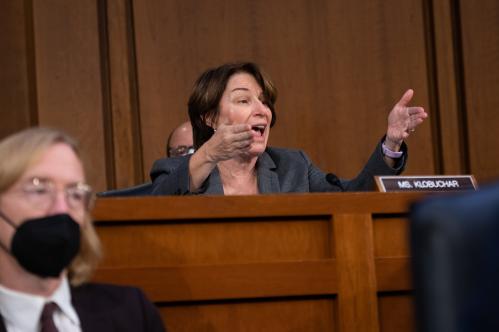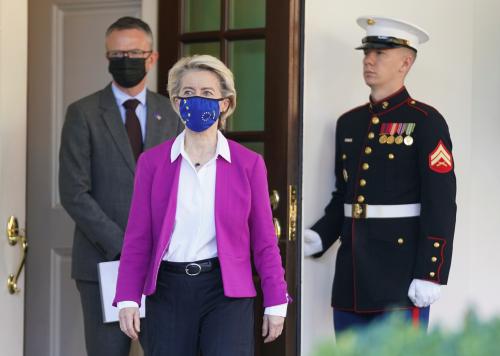Although there is a general sentiment among lawmakers in the European Union (EU) and United States that competition reform may be necessary to curb anticompetitive practices by dominant digital platforms, there is considerably less consensus over which companies any new ex ante legislation should apply to. In a bipartisan letter to President Biden last month, 30 members of Congress criticized the EU’s Digital Markets Act (DMA), arguing that the draft legislation “unfairly targets American workers by deeming certain U.S. technology companies as ‘gatekeepers’ based on deliberately discriminatory and subjective thresholds.” These legislators, along with other critics, contend that the proposed EU competition rules—which would address practices like self-preferencing, anti-steering, data access, data portability, and interoperability—contain criteria that would primarily pertain to a small number of U.S. corporations like Meta, Apple, Google, Amazon, and Microsoft, while potentially exempting many EU or Chinese platforms.
But to those following antitrust developments in the United States, their objections may sound familiar. While the House Judiciary Committee voted in favor of six competition bills in June 2021 to address similar practices, and the Senate Judiciary Committee advanced Sens. Amy Klobuchar (D-MN) and Chuck Grassley’s (R-Iowa) American Innovation and Choice Online Act in January 2022, several of these U.S. federal bills also face some internal challenges from members of both parties over the scope of their application. Senator Dianne Feinstein (D-CA) recently summarized such concerns, stating that “it’s difficult to see the justification for a bill that regulates the behavior of only a handful of companies, while allowing everyone else to continue engaging in that exact same behavior.”
Covered platforms and gatekeepers in the United States and European Union
Both the U.S. and EU legislation would only apply to companies that fall within certain categorical or size thresholds. Klobuchar and Grassley’s American Innovation and Choice Online Act would generally propose new nondiscrimination requirements for “covered platforms” with (1) at least 50 million U.S. monthly active users or 100,000 U.S. monthly active business users; (2) a market capitalization or net annual sales of over $550 billion; and (3) the ability to restrict user searches, user-generated content, or sales of third-party goods or services. The House bills that advanced out of committee last year—including Reps. David Cicilline (D-RI) and Lance Gooden’s (R-Texas) American Choice and Innovation Online Act and Reps. Gooden and Pramila Jayapal’s (D-WA) Ending Platform Monopolies Act—contain similar standards, except with a higher market capitalization threshold of $600 billion. Like the DMA, these measures also appear to target Apple, Meta, Google, and Amazon under current market conditions (with some uncertainty over whether it would also cover Microsoft), although other digital platforms could potentially qualify if they grow in size in the future.
In December 2020, the European Commission proposed certain quantitative criteria to define “gatekeepers,” or the digital platforms which would generally be subject to the DMA’s new pro-competition rules: companies that operate in at least three member states with (1) either €6.5 billion in annual gross revenue within the European Economic Area (EEA) or a €65 billion overall market capitalization and (2) 45 million active monthly users and 10,000 annual active business users within the EU. In December 2021, the European Parliament voted to amend the first threshold to €8 billion in net revenue in the EEA or an €80 billion market capitalization respectively. Still, both the European Commission and Parliament versions inject some degree of subjectivity into this definition. Companies that meet these quantitative standards may still be exempt from the provisions of the act, either through “exceptional circumstances” or “further investigations.” On the other hand, those which fall short of the metrics could still be required to comply with the DMA if the European Commission determines that “it is foreseeable that it will enjoy [an entrenched and durable] position in the near future.”
Focus on network effects and data, not market capitalization
Despite the opposition from some legislators, it is understandable that both Congress and the European Commission want to target antitrust reform toward large technology companies that have the greatest potential to pose anticompetitive harms. In particular, the House Antitrust Subcommittee majority investigation, which concluded in 2020, not only found that Amazon, Apple, Google, and Meta were collectively worth over $5 trillion at that time, but that they had engaged in behavior that included self-preferencing their own products and services on their platforms, acquiring potential competitors, and more. Such concerns are magnified by trends of rising market concentration in the broader U.S. and EU economies over the past few decades, especially in industries like search engines or e-commerce, as well as declining startup formation and higher rates of merger and acquisition (M&A) activity in the United States during this period. Accordingly, the debate should not center around whether or not legislation should target dominant platforms, but which metrics are appropriate to determine which platforms should be covered.
When setting objective criteria to determine whether a specific company is dominant enough to require new ex ante competition rules, the challenge is to both anticipate risks of anticompetitive harms and to find benchmarks that will synchronously apply to platforms with differing business models or situated within diverse or undefined markets. Market capitalization may seem like one obvious choice for legislators, as it presents a seemingly straightforward benchmark to either include or exclude companies from legal compliance with an act. When the United Kingdom sought public comments in July 2021 over the scope of a new Digital Markets Unit to oversee technology companies within its existing Competition and Markets Authority, it commented on the usefulness of clear metrics by which to prioritize cases: “a firm’s revenue provides an indication of the scale of harm that could result from a firm’s market power, so is a useful proxy [that] would also provide additional clarity to firms—particularly smaller digital firms—on whether they are likely to be assessed for designation.” Although the UK public consultation does not specifically reference market capitalization or a number of users, the EU and U.S. legislation pairs market capitalization and revenue together. Market capitalization is a larger determining factor than revenue for Meta, Google, Apple, and Amazon under the U.S. legislation, since each company currently has a valuation of above $550 billion but annual net incomes below that benchmark in the previous two years.
But what makes these four technology companies different from the monopolists of the past—and what any new antitrust law should recognize—is not their market capitalization, but their business models that benefit from massive data collection and network effects. Through products like Amazon Basics, Google Search, Instagram, and the App Store, these four companies often charge individual users either no or low monetary fees for certain services—but collect significant amounts of personal information (including geolocation, browsing or shopping history, photos or videos, device identifiers, and more), which can be used to target advertisements, develop algorithms, and improve products or services. Furthermore, each of the four platforms has amassed hundreds of millions of users and then benefit from network effects—where individuals are more likely to use platforms that already have massive user or seller bases, and where a platform’s value exponentially increases based on their popularity. Newer startups do not replicate this same number of users or these data troves, which, arguably more than revenue or market capitalization, entrenches large players in the market.
Despite the clarity that a benchmark like market capitalization would bring, a company can still use network effects and its accumulation of big data even regardless of its monetary valuation. On February 2, Meta’s stock price plummeted over 26% in a single day, equivalent to an approximate capitalization loss of $230 billion—where it has hovered for the past month and a half at a valuation under $600 billion, below the threshold of the House legislation. Even though the House bills would maintain some buffer against unpredictable stock market fluctuation by applying to companies with a market capitalization of $600 billion at any point within the past two years, this event still demonstrates that a company like Meta can lose or gain a significant amount of market value without an equally meaningful change in its number of users, data collection practices, market dominance, or M&A strategy. In other words, market capitalization primarily measures a company’s size—it does not necessarily parallel its potential to pose anticompetitive harms. To avoid exempting dominant platforms from any new pro-competition rules, it would make sense to significantly lower the market capitalization threshold in U.S. antitrust legislation, or even eliminate it from consideration at all.
Qualitative standards for market dominance
With a proposed market capitalization threshold of €80 billion—just a fraction of the respective $550 and $600 billion benchmarks in the U.S. Senate and House bills—the EU’s DMA targets a small number of dominant digital platforms even with a much lower market valuation threshold. In part, this is because the DMA also considers more qualitative metrics, such as whether a potential gatekeeper has a “significant impact” on a market, to either include or exclude platforms from the provisions of the bill, in addition to its quantitative thresholds. In its public consultation, the UK similarly proposed qualitative metrics to consider which competition cases the Digital Markets Unit might prioritize, including whether network effects and barriers to entry might exacerbate concentration in a particular market, and whether other sector-specific entities exist to regulate certain companies.
The EU and UK models also include other factors, apart from numerical standards like market capitalization, that focus on the potential harms from market concentration. The United States might consider a similar approach. The Senate and House bills both currently authorize the Federal Trade Commission (FTC) and Department of Justice (DOJ) to designate “covered platforms” based on the quantitative criteria mentioned above, but Congress could go further to specify additional, more qualitative guidelines for the agencies to consider depending on the targeted business practice, such as scope of data collection, strategic role of network effects, and any other factors that may enhance market concentration, barriers to entry, or overall position to impose anticompetitive conditions for either individual users or other businesses.
Based on these additional qualitative considerations, Congress should direct the FTC and DOJ to establish a process to solicit stakeholder input on whether a business should or should not qualify as a “covered platform” under an act—even if a company either does not or only partially meets the other quantitative benchmarks outlined in legislation. Likewise, Congress should also direct the FTC and DOJ to periodically evaluate and adjust both the quantitative and qualitative criteria for a covered platform to account for any future changes in technology, business models, macroeconomic conditions, or overall markets for digital platforms. For example, both the EU and U.S. legislation currently include the number of users as a quantitative factor in a platform’s eligibility—and although this is a relevant consideration for digital market dominance, especially given the role of network effects, evolving market conditions and demographic trends over decades could call for adjustments in the specific numerical figures. Overall, this procedure would allow federal enforcement agencies to conduct a more detailed analysis to determine which individual companies should be subject to new ex ante competition rules, thus addressing the challenge that Congress would otherwise face to select statutory criteria that anticipates market dominance over a large range of industries, business models, and changing market conditions.
In conclusion, both Congress and the European Commission are right to direct competition scrutiny toward Big Tech. Yet, many large digital platforms derive their true power from their users, network effects, and vast scope of data collection. Market capitalization, while often hefty, is not an important measure by which to determine which dominant digital platforms should be required to comply with any new pro-competition rules.
Amazon, Apple, Google, and Facebook are general, unrestricted donors to the Brookings Institution. The findings, interpretations, and conclusions posted in this piece are solely those of the author and not influenced by any donation.
The Brookings Institution is committed to quality, independence, and impact.
We are supported by a diverse array of funders. In line with our values and policies, each Brookings publication represents the sole views of its author(s).








Commentary
Market capitalization is not the right focus for U.S. and EU antitrust reform
March 22, 2022